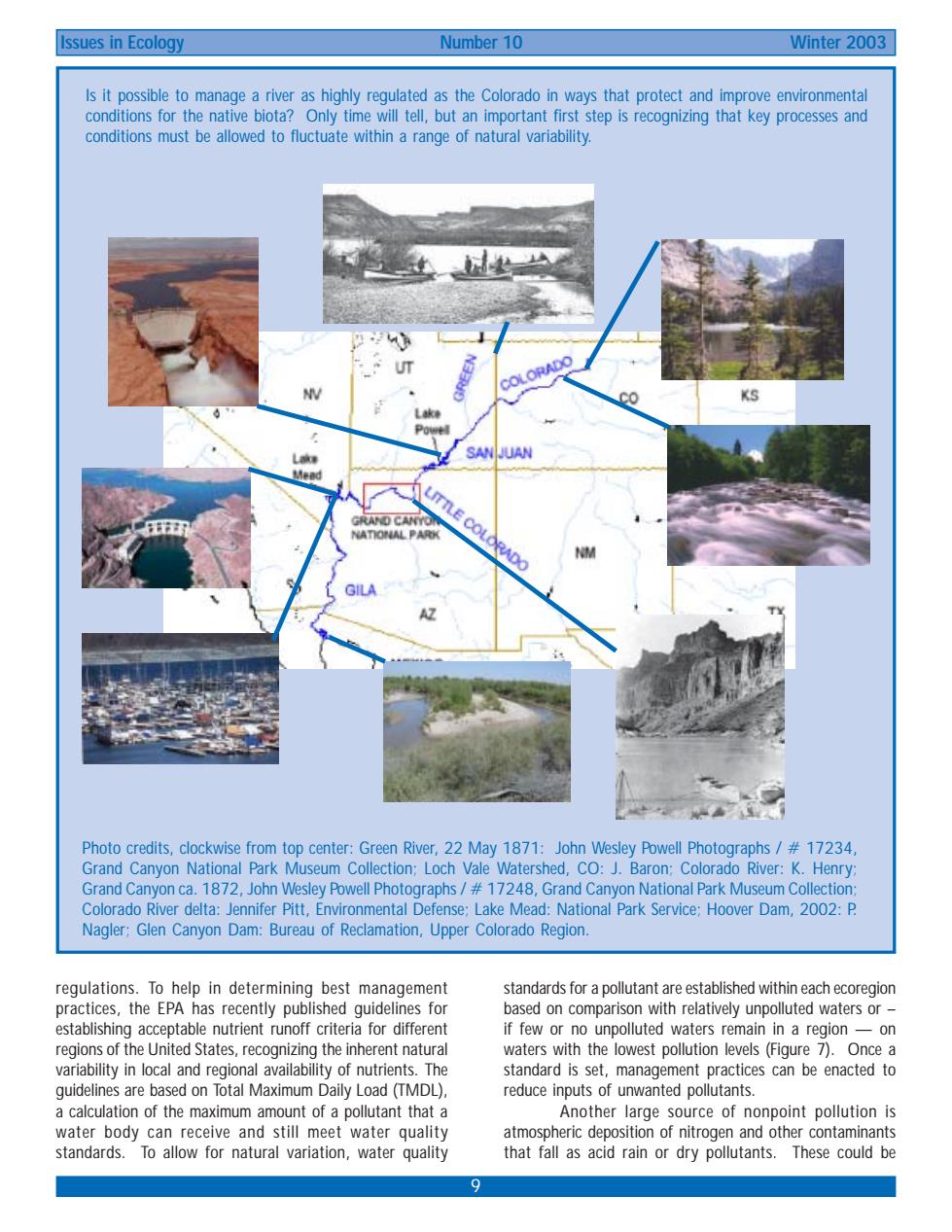正在加载图片...

Issues in Ecology Number 10 Winter 2003 Is it possible to manage a river as highly regulated as the Colorado in ways that protect and improve environmental conditions for the native biota?Only time will tell,but an important first step is recognizing that key processes and conditions must be allowed to fluctuate within a range of natural variability. co SAN JUAN GILA Photo credits,clockwise from top center:Green River,22 May 1871:John Wesley Powell Photographs/#17234 Grand Canyon National Park Museum Collection:Loch Vale Watershed,CO:J.Baron:Colorado River:K.Henry Grand Canyon ca.1872.John Wesley Powell Photographs/#17248,Grand Canyon National Park Museum Collection Colorado River delta:Jennifer Pitt,Environmental Defense:Lake Mead:National Park Service:Hoover Dam,2002:P Nagler:Glen Canyon Dam:Bureau of Reclamation,Upper Colorado Region. reaulations to help in determinina best management standards for a pollutant are established within each ecoregion practices.the EPA has recently published quidelines for based on comparison with relatively unpolluted watersor establishing acceptable nutrient runoff criteria for different if few or no unpolluted waters re main in a region on regions of the United States,recognizing the inherent natural waters with the lowest pollution levels (Figure )Once a variability in local and regional availability of nutrients.The standard is set,management practices can be enacted to guidelines are based on Total Maximum Daily Load (TMDL). reduce inputs of unwanted pollutants. a calculation of the maximum amount of a pollutant that a Another large source of nonpoint pollution is water body can receive and still meet water quality atmospheric deposition of nitrogen and other contaminants standards.To allow for natural variation,water quality that fall as acid rain or dry pollutants.These could be 9 Issues in Ecology Number 10 Winter 2003 Photo credits, clockwise from top center: Green River, 22 May 1871: John Wesley Powell Photographs / # 17234, Grand Canyon National Park Museum Collection; Loch Vale Watershed, CO: J. Baron; Colorado River: K. Henry; Grand Canyon ca. 1872, John Wesley Powell Photographs / # 17248, Grand Canyon National Park Museum Collection; Colorado River delta: Jennifer Pitt, Environmental Defense; Lake Mead: National Park Service; Hoover Dam, 2002: P. Nagler; Glen Canyon Dam: Bureau of Reclamation, Upper Colorado Region. Is it possible to manage a river as highly regulated as the Colorado in ways that protect and improve environmental conditions for the native biota? Only time will tell, but an important first step is recognizing that key processes and conditions must be allowed to fluctuate within a range of natural variability. regulations. To help in determining best management practices, the EPA has recently published guidelines for establishing acceptable nutrient runoff criteria for different regions of the United States, recognizing the inherent natural variability in local and regional availability of nutrients. The guidelines are based on Total Maximum Daily Load (TMDL), a calculation of the maximum amount of a pollutant that a water body can receive and still meet water quality standards. To allow for natural variation, water quality standards for a pollutant are established within each ecoregion based on comparison with relatively unpolluted waters or – if few or no unpolluted waters remain in a region — on waters with the lowest pollution levels (Figure 7). Once a standard is set, management practices can be enacted to reduce inputs of unwanted pollutants. Another large source of nonpoint pollution is atmospheric deposition of nitrogen and other contaminants that fall as acid rain or dry pollutants. These could be